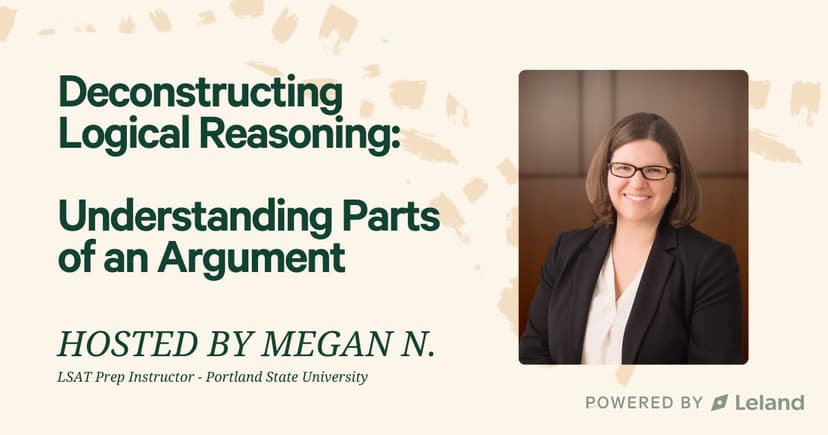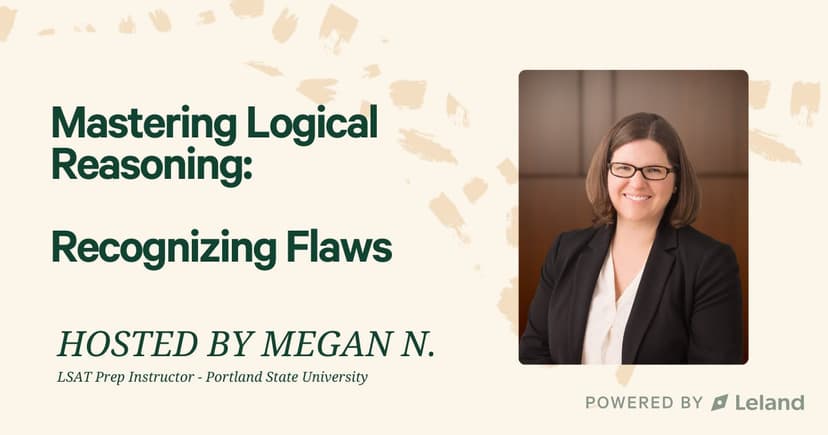LSAT Logical Reasoning Strategies for Flaw Questions
Looking to ace the LSAT Logical Reasoning section? Check out our expert tips and strategies for flaw questions.

By Eshaan S.
99th Percentile Experienced Tutor w/ Proven Results!
Posted October 2, 2025

Join a free event
Learn from top coaches and industry experts in live, interactive sessions you can join for free.
Table of Contents
Flaw questions in the LSAT Logical Reasoning section are among the most nuanced and challenging for test-takers. These questions demand a sharp eye for identifying flawed reasoning within arguments and selecting the correct answer choice from a range of tempting but incorrect answer choices. This guide provides a comprehensive breakdown of flaw questions, offering strategies to tackle them with confidence and precision.
I am an LSAT tutor with 5+ years of experience helping applicants achieve top scores. I personally scored a 175 on the exam and love bringing personalization and dedication to my tutoring practice, helping students overcome plateaus and reach the scores they need to get admitted to their dream law programs.
This guide provides a comprehensive approach to tackling these question types, focusing on practical strategies, key insights, and techniques to improve accuracy and confidence.
To boost your logical reasoning skills and confidence, check out The 30 Best Resources for the Logical Reasoning Section of the LSAT.
What Are Flaw Questions in the LSAT Logical Reasoning Section?
Flaw questions test your ability to identify instances where the author's conclusion is not necessarily true. These questions present an argument and ask you to determine how the reasoning is flawed. Rather than evaluating the argument’s conclusion directly, you must focus on the reasoning used to support it. Common logical errors include:
- Circular reasoning
- Correlation versus causation fallacies
- Ad hominem attacks
- Overgeneralizations
- Not Proven = False
- Sampling Error
- False Dichotomy
- False Equivocation
Understanding the distinct types of flawed reasoning is essential to excelling in this section. Identifying flaws, such as when an argument relies on unsupported assumptions or draws inappropriate connections between ideas, is a key skill for achieving a high score.
Common Types of Flaws Tested
The LSAT Logical Reasoning section often features recurring patterns of flawed reasoning. Understanding these flaws is crucial for efficiently analyzing arguments and identifying their weaknesses. Below are the key types of flaws you should familiarize yourself with:
Circular Reasoning
Circular reasoning occurs when the argument’s conclusion simply restates one of its premises. Instead of providing additional support, the conclusion relies on the premise as evidence, creating a logical loop. For example, consider the statement: "The product is the best because it is superior to all others." This reasoning fails to provide any new justification and simply reiterates the conclusion: “it is the best because it is the best”.
Correlation vs. Causation Fallacies
These fallacies occur when an argument assumes a causal relationship based solely on a correlation between two events. The reasoning fails to consider other potential explanations for the observed connection. For example, "Ice cream sales increase during summer, so eating ice cream must cause heat waves" confuses a coincidental pattern with causation. The author’s implication that X - ice cream consumption - causes Y - heat waves - is incorrectly justified by the fact that X occurred before/at the same time as Y.
Ad Hominem Attacks
Ad hominem attacks focus on criticizing the individual presenting the argument rather than addressing the argument itself. These flaws undermine reasoning by diverting attention to irrelevant personal traits or behaviors. For instance, saying, "You shouldn’t trust their opinion on climate change; they drive a gas-guzzling car," does not address the validity of their argument but instead shifts focus to their personal choices.
Sampling Flaw
Sampling flaws involve drawing broad conclusions from an unrepresentative or biased sample. This weakens the argument because the evidence does not accurately reflect the larger group. For instance, "All students at this school love math because the top-performing math students said so" fails to account for the opinions of students outside the sample group. The author overgeneralizes from the biased, limited sample size of the school’s top performers.
False Dichotomies
False dichotomies present only two extreme options, ignoring other possible alternatives. This oversimplification forces a choice between incomplete or inaccurate options. For example, the argument "Either we ban all technology, or society will collapse" ignores a range of intermediate possibilities, such as regulating technology use.
False Equivocation
False Equivocation occurs when the author uses a term in two different places, with different definitions, without noting the change in meaning.
Strategies for Answering Flaw Questions on the LSAT
Answering flaw questions effectively requires a tactical and structured approach. These questions test your ability to analyze arguments critically and identify errors in reasoning. By following these steps, you can approach flaw questions with confidence and precision:
- Read the argument carefully - Begin by thoroughly reading the argument to identify its premises and conclusion. Understanding the structure of the argument is crucial to spotting flaws. Pay close attention to how the premises support—or fail to support—the conclusion. Avoid skimming, as subtle nuances often hold the key to uncovering reasoning errors. Most of my students, by far, rush through this step and are unclear about the author’s claim and support referenced, and quickly find themselves confused by the provided Answer Choices.
- Spot the flaw - Pinpoint the specific reasoning failure within the argument. Does the argument rely on unsupported assumptions? For example, does it assume a causal relationship without evidence? Does it overlook alternative explanations or misinterpret the relationship between the premises and the conclusion? Training yourself to recognize these patterns is essential for success.
- Eliminate irrelevant answer choices - Many wrong answer choices are designed to distract you by including irrelevant details or misrepresenting the argument’s reasoning. By identifying a potential beforehand, you have an idea of what the right answer should sound like. I refer to this as the scope of the author’s argument; wrong answers should be blatantly unrelated to the author’s claims or premises. Carefully analyze each choice to discard options that fail to directly address the flaw in the argument. This step helps narrow down your choices, making the decision process more manageable.
- Compare remaining options - Once you’ve narrowed down your options, ensure the correct answer choice accurately describes the specific reasoning error. Look for precision in the language and alignment with the identified flaw. Be cautious of vague or overly general answers that may seem applicable but do not specifically address how the argument fails.
- Leverage your own words to clarify flaws - Rephrase the identified flaw in your own words before reviewing the answer choices. This helps crystallize your understanding of the argument’s error, making it easier to match the flaw with the correct answer. Simplifying the language used on the LSAT is one of the most efficient ways to improve understanding on the LSAT. Be alert for traps, such as answers that describe part of the argument accurately but fail to capture the actual reasoning error.
Additional Tips for Tackling Flaw Questions
- Keep your attention on the reasoning process rather than getting distracted by the content or conclusion. Even if the conclusion is valid, flawed reasoning undermines the argument.
- Use practice questions to familiarize yourself with common flaw patterns and improve your ability to spot errors under timed conditions.
- Understanding why an answer choice is incorrect can deepen your insight into LSAT logic and help you avoid similar traps in the future.
- Trust your analysis and avoid second-guessing yourself once you have logically eliminated incorrect options.
Common Traps to Avoid
Flaw questions on the LSAT can be particularly deceptive, as wrong answer choices are often crafted to mislead test-takers. One of the most common pitfalls is focusing solely on the argument’s conclusion while neglecting its premises. While the conclusion is an essential part of the argument, the reasoning errors often lie in how the premises attempt to support it. Overlooking the premises can obscure critical flaws and lead to incorrect conclusions about the argument's validity.
Another frequent mistake is assuming that all irrelevant information within the argument constitutes a flaw. Not every extraneous detail represents flawed reasoning. It’s important to differentiate between elements that are merely irrelevant and those that actively weaken or misrepresent the argument’s logic. Misidentifying irrelevant details as flaws can distract from the actual reasoning errors.
Test-takers also commonly fall for reverse flaws, where an answer choice appears to describe the argument’s flaw but actually commits the same error in reverse. These traps are particularly tricky because they mimic the structure of legitimate reasoning errors, requiring careful attention to detail to distinguish them from correct answers.
To navigate these pitfalls, it is crucial to apply critical thinking and remain methodical in your approach. Carefully analyzing the argument, evaluating its reasoning, and staying alert to these traps will help you choose the correct answer more consistently. Developing this disciplined approach will not only improve your accuracy but also boost your confidence in tackling flaw questions effectively.
Step-by-Step Guide to Flaw Questions
Flaw questions challenge your ability to analyze how an argument draws its conclusion from the premises. These questions often test whether the reasoning is logically sound or if it contains gaps or unsupported assumptions. Following a clear process will help you navigate these questions with confidence and accuracy.
Step 1: Identify the Premises and Conclusion
Begin by breaking down the argument to understand its structure. The premises are the statements provided as evidence, and the conclusion is the claim that the argument is trying to prove. Look for indicator words like "because," "since," or "therefore" to distinguish these elements. A clear understanding of how the premises and conclusion relate is essential because the flaw typically lies in the reasoning connecting them.
Step 2: Analyze the Reasoning
Examine the logic used to connect the premises to the conclusion. Ask yourself if the argument assumes something unsupported or overlooks an alternative explanation. For example, does the argument infer causation where there is only correlation? Or does it rely on a generalization from an insufficient sample? Spotting these reasoning gaps will help you pinpoint the flaw.
Step 3: Consider Common Flaws
Compare the argument to known patterns of flawed reasoning frequently tested on the LSAT. These may include circular reasoning, ad hominem attacks, correlation vs. causation errors, or false dichotomies. Familiarity with these patterns can expedite your ability to categorize the flaw and anticipate likely answer choices.
Step 4: Evaluate the Answer Choices
Carefully review each answer choice and eliminate those that are vague, overly broad, or irrelevant to the identified flaw. Focus on selecting the option that accurately describes the specific reasoning error. Be cautious of answers that describe only part of the argument or misrepresent the flaw.
Using Practice and Visual Aids
Consistent practice is key to mastering flaw questions. Resources like LSAT prep books and online forums offer invaluable tools for identifying flawed reasoning and sharpening analytical skills. These materials provide a range of examples to help you recognize common patterns of flawed reasoning and refine your approach to answering flaw questions effectively.
Visual aids can also be powerful tools in analyzing arguments. For instance, flowcharts allow you to outline the premises and conclusion, making it easier to spot inconsistencies or logical gaps. Diagrams, on the other hand, can help map out logical relationships and identify errors in causal reasoning. Both techniques provide a structured way to break down complex arguments and visualize their flaws.
Engaging with real-life examples of flawed arguments can further enhance your skills. Look for instances where an argument’s reasoning is vulnerable to criticism due to unwarranted assumptions or logical errors. Practicing this kind of critical analysis not only prepares you for LSAT questions but also improves your overall reasoning ability. Additionally, try drafting your own flawed arguments and analyzing their weaknesses. This exercise will deepen your understanding of flawed reasoning and strengthen your ability to identify it quickly and accurately during the exam.
Expert Tips from High Scorers
High scorers on the LSAT consistently emphasize the importance of a strategic approach to mastering flaw questions. Here are their top tips:
- Focus on practicing quality over quantity by thoroughly analyzing each answer choice. Understand why the correct answer is right and why the other options are incorrect. This deep analysis helps recognize patterns in flawed reasoning and improves your ability to select the right answer under pressure.
- Study common logical fallacies extensively to enhance speed and accuracy. Familiarity with patterns like circular reasoning, ad hominem attacks, and false dichotomies enables you to quickly identify reasoning errors and anticipate traps in LSAT questions.
- Analyze wrong answer choices to understand why a particular answer was tempting but ultimately incorrect. This reflective process sharpens your critical thinking skills and reinforces your ability to evaluate answer choices critically.
- Simulate test conditions by practicing under timed settings to improve pacing and manage the pressure of the Logical Reasoning section. Use realistic practice tests to identify areas needing efficiency improvements.
- Build resilience and focus by maintaining consistent, focused study sessions while avoiding burnout. Incorporate tools like diagrams or flowcharts to break down complex arguments and identify reasoning errors more effectively.
- Seek feedback from peers, tutors, or study groups to gain alternative perspectives and refine your analytical approach. High scorers often attribute their success to a combination of self-reflection, collaboration, and disciplined practice.
How to Improve Critical Thinking Through Practice
Developing critical thinking skills not only prepares you for the LSAT but also equips you to identify flawed arguments in daily life. For example, a particular argument presented in the media may confuse correlation with causation or rely on anecdotal evidence rather than scientific evidence. Analyzing such arguments can enhance your ability to spot the same flaw in LSAT questions. Additionally, practicing how to describe flaws in your own arguments can deepen your understanding of logical reasoning.
By dissecting how an argument confuses necessary and sufficient conditions or identifying when it relies on unsupported assumptions, you can sharpen your analytical skills. Engaging critically with these patterns will prepare you to evaluate reasoning errors effectively and confidently describe the correct answer during the exam.
How Top LSAT Coaches Can Help Tackle LSAT Flaw Questions
Flaw questions in the LSAT Logical Reasoning section require a deep understanding of logical fallacies and a tactical approach. Top LSAT coaches provide invaluable guidance in mastering these challenging questions. They offer personalized strategies tailored to your strengths and weaknesses, ensuring you can identify reasoning errors and approach each question methodically.
Experienced coaches can help you break down complex arguments, recognize common logical fallacies, and avoid traps set by tempting but incorrect answer choices. By working with a top LSAT coach, you gain access to expert insights, targeted practice materials, and actionable feedback that sharpen your critical thinking skills.
Get Help From a College Admissions Coach
Applying to college can be hard, but you don’t have to do it alone. A college admissions coach can help you write better essays, choose the right schools, and make your application stronger. Work one-on-one with a coach who knows what top schools are looking for and has helped students get in.
Read these next:
- What is the LSAT Out Of & What's a Good Score?
- LSAT Reading Comprehension Guide: Tips, Strategies, & Practice
- Law Schools That Don't Require the LSAT: Exploring Your Options
- 10 Ways to Strengthen Your LSAT Reading Comprehension
- LSAT vs. GRE for Law School–Which to Take and How to Ace Both
- Top 30+ Free Resources for the LSAT
- The 10 Best College Admissions Consultants
Eshaan S. is an LSAT tutor who has been helping applicants reach top scores since 2020. He himself scored a 175 and is passionate about helping students navigate the roadbumps that come with acing standardized tests. His coaching methodology is highly customized to each student’s strengths and weaknesses, ensuring that every lesson is geared toward personalized improvements. Book a free intro call with Eshaan and reach your target LSAT score.
FAQs
How to improve flaw questions in LSAT?
- Generally, students improve in flaw questions by becoming stronger at prephrasing. The better you know what you are looking for in a correct answer choice, the faster and more accurate you'll be. The other piece of advice is to remember that half-right, half-wrong answer choices are all wrong.
How can I improve my logical reasoning for the LSAT?
- Practice Regularly: Logical reasoning is a skill that improves with practice. Solve puzzles, take practice tests, and work on a variety of logic-based problems to enhance your reasoning abilities.
What is the flawed pattern of reasoning on the LSAT?
- A flawed pattern of reasoning on the LSAT is a logical error in an argument's structure or reasoning. This might include making incorrect assumptions, drawing conclusions that aren't supported by the premises, or using faulty logic.
What is the most common flaw on the LSAT?
- Confusing sufficient and necessary conditions is hands-down the most common flaw on the LSAT. It's also the flaw that tends to trip up novices the most. But understanding the difference between sufficient and necessary is a lot simpler than you might think.
What is the best guessing strategy for the LSAT?
- You must take the time to mark down an answer for each question, even if you don't get to it. I recommend choosing one answer choice and making it your guess for all of the remaining questions—statistically, if you guess the same letter on five questions, this should mean that you're correct at least once.

Written by Eshaan
4.8
(21)
Eshaan has helped clients get into organizations like:
Browse hundreds of expert coaches
Leland coaches have helped thousands of people achieve their goals. A dedicated mentor can make all the difference.
















